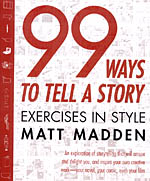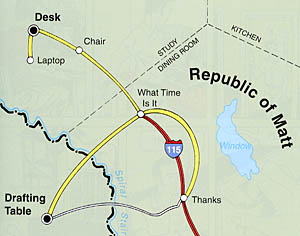 By Matt Madden
By Matt Madden
224 pages, black and white, one color insert
Published by Chamberlain Bros.
One of my favorite “how-to” books in comics is, in many ways, less a “how-to” book and more like a piece of performance art. Matt Madden’s 99 Ways to Tell a Story: Exercises in Style is a book that should be used in any sort of comic class, showing over and over again that there really is more than one way to tell a story, even something as simple as wandering across the apartment.
99 Ways to Tell a Story was inspired by Raymond Queneau’s Exercises in Style, where Queneau starts off with a simple story, then proceeds to tell it again and again, but in different forms (different tenses, pig latin, morse code, as a sonnet, and so forth). It’s from that idea that Madden writes and draws 99 Ways to Tell a Story. It begins with a one-page story simply titled “Template” where Madden gets up from his desk and walks down the hall. His wife calls from upstairs asking what time it is; after he answers, Madden goes to the fridge and staring inside, wonders what he was looking for in the first place. And then, that’s where the fun begins.
 At first the shifts are simple but interesting. Madden shifts the comic so each panel is drawn by what his character is seeing, a first-person view. Other versions are from his wife’s perspective upstairs, or from the view of the refrigerator. And then, things start getting really different. The story rewinds backwards, but still makes sense. The panels are drawn from a fixed horizon. The sequence is told in recollection the next day (while still feeding into the new day’s events).
At first the shifts are simple but interesting. Madden shifts the comic so each panel is drawn by what his character is seeing, a first-person view. Other versions are from his wife’s perspective upstairs, or from the view of the refrigerator. And then, things start getting really different. The story rewinds backwards, but still makes sense. The panels are drawn from a fixed horizon. The sequence is told in recollection the next day (while still feeding into the new day’s events).
 Madden gets more and more inventive as the book progresses. There’s a “Newly Discovered Section of the Bayeaux Tapestry” which had me on the floor in hysterics, for instance. He apes other comics styles, from EC horror comics and hardboiled gumshoe stories, to Tintin and Dreams of a Rarebit Fiend. My two favorite versions, though, are two that keep the inventive nature of the book high but take it into the completely different ways to tell a story. The first is reformatting the story as a map, with locations like the desk and fridge being cities in the Republic of Matt, while the United States of Jessica is where the drafting table is located. Roads show both the intended path as well as the devours, and even the different rooms become counties or states within these countries (and the spiral staircase leading upstairs is now a river the delineates the boundary between these two countries). It’s amazingly clever and inventive, and tells the story in a way I could have never imagined. Likewise, “Brought to You By…” jumps into a completely different medium, the narrative told as a series of old-style advertisements. It’s a fairly brilliant variant on telling the story, and works surprisingly well.
Madden gets more and more inventive as the book progresses. There’s a “Newly Discovered Section of the Bayeaux Tapestry” which had me on the floor in hysterics, for instance. He apes other comics styles, from EC horror comics and hardboiled gumshoe stories, to Tintin and Dreams of a Rarebit Fiend. My two favorite versions, though, are two that keep the inventive nature of the book high but take it into the completely different ways to tell a story. The first is reformatting the story as a map, with locations like the desk and fridge being cities in the Republic of Matt, while the United States of Jessica is where the drafting table is located. Roads show both the intended path as well as the devours, and even the different rooms become counties or states within these countries (and the spiral staircase leading upstairs is now a river the delineates the boundary between these two countries). It’s amazingly clever and inventive, and tells the story in a way I could have never imagined. Likewise, “Brought to You By…” jumps into a completely different medium, the narrative told as a series of old-style advertisements. It’s a fairly brilliant variant on telling the story, and works surprisingly well.
99 Ways to Tell a Story works best when read in short bursts; I can see it getting a little overwhelming to try and read all 99 different variations at once. What’s nice, though, is that I’ve found you can pick up 99 Ways to Tell a Story and read pages that you’ve gone through before and find them just as fun and interesting with each re-reading. Madden’s imagination is on display in full force here, and the end result is nothing short of delightful. If you’ve ever thought about creating comics, or just want to see a challenge taken to its impressive conclusion, definitely take a look at this book.
Purchase Links:
